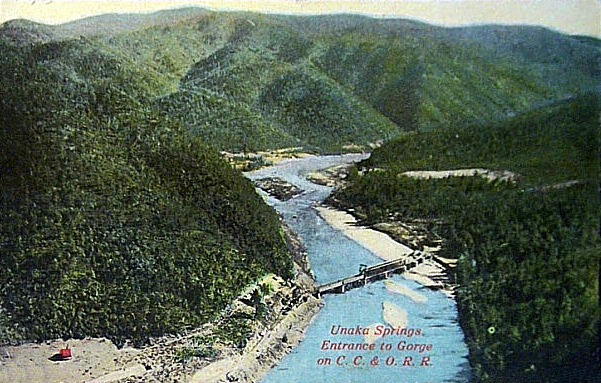At the turn of the nineteenth century, residents and tourists had a wide variety of options for spending restful vacation time in the statuesque hills of East Tennessee. They ranged from pricey upscale hotels to affordable rustic lodgings.
In the latter category was Unaka Springs, a natural, peaceful paradise located about 18 miles from Johnson City in Unicoi County, a few miles past Erwin along a mountainous portion of the Nolichucky River. The river was originally named Nolachucky, meaning “Rushing Water”.

In August 1899, The Comet advised vacationers who couldn’t afford a high-priced summer resort but wanted to circumvent a hot city atmosphere to choose Unaka Springs. It was a setting where travelers could keep cool, drink chalybeate water, fish, hunt, boat, hike, mountain climb, swim, dance and consume plenty of scrumptious food.
If the vacationer was seeking relaxation, clean air, good butter, pure milk and fresh fish, Unaka Springs was the place to be. Added benefits included viewing nature in all its glory, listening to soothing rippling river waters and forgetting about life’s displeasures while being surrounded by towering peaks that rise all around you.
Unaka Springs was considered one of the finest mineral springs in the south. Chalybeate water became popular with folks who believed in its health enhancing qualities. A physician from early times gave a unique description of it: “The colic, the melancholy, and the vapours; it made the lean fat, the fat lean; it killed flat worms in the belly; loosened the clammy humours of the body; and dried the over-moist brain.” He further stated in rhyme: “These waters youth in age renew, Strength to the weak and sickly add, Give the pale cheek a rosy hue, And cheerful spirits to the sad.”
The springs could be reached by hack (a horse for hire that could be used for riding or driving) easily in half a day. A regular hack line ran from Jonesboro to the hotel. After passing Erwin, the road followed the Nolichucky River the last two miles of the journey. The scenery along the route was more than worth the cost of the trip.
Some people preferred to make the journey by train. A timecard from 1893 shows CC&C Railroad’s “No. 1 Daily” leaving Johnson City’s Carnegie Depot (Fairview Avenue) at 7:30 a.m.; traveling to Okolona, Fagans, Marbleton, Rose Hill, Unicoi, Erwin; and arriving at Unaka Springs at 8:45 a.m., a journey of an hour and a quarter.
After crossing the river and entering the hotel grounds, guests were completely and wonderfully isolated from the outside world. The pristine river was full of perch, waiting for guests to come and catch them (if they could). Surrounding the hotel were mountains so close that all guests had to do was step off the porch and begin ascending them. The Comet advised people, upon arrival at the quaint hotel, to stop and converse with the landlord, Mr. A.V. Deaderick, a noted photographer who operated his studio there.
James A. Goforth (former Clinchfield Railroad engineer and Erwin historian) noted in his book, Erwin, Tennessee: A Pictorial History (Overmountain Press, 2004) that the hotel was a three-story frame structure with modern plumbing and a full porch along the front. Rental rates were $2/day, $10/week and $30/month. An ad from that era firmly stated, “no consumptives.”
The highlight of the evening was when Uncle “Dot” blew his dinner horn signaling guests that the evening meal was being served. This brought people scampering to the table for a sampling of tasty cuisine. The enterprising Comet was so certain that visitors to Unaka Springs would be satisfied with their trip there that they cleverly agreed to refund the cost of having their newspapers mailed to them while on vacation if they were not happy with the stopover.
